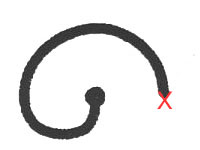On the labyrinth congress in Dresden (Germany) I received among other things also a small flyer, on which Heike Arndt stated, how one can make oneself a labyrinth. She permitted me kindly to pass this knowledge on and I do this hereby.
With this method Ariadne’s thread, thus the way, which one goes is developed. And not, as usually, the lines, delimitating the way, between which one goes. A labyrinth for this kind of representation is particularly suitable in the snow or at the beach in the sand, where one can scratch something. Or one paints it with chalk on a firm underground.
In Dresden Heike demonstrated this also in the hall. On a foil, covered with groats, which one can push aside with the feet.
At the performance in front of the Dresdener Frauenkirche it was the other way round. There the groats served to mark Ariadne’s thread on the pavement, which was walked by the participants.
Ariadne’s Thread –
developing a labyrinth:
Make you a circle, aligned at the four directions and strike a cross over it, connect the North with the South and the East with the West. Now you have a center. Here your labyrinth has root and crown, connects the down with the above.
Dance round the center three times, changing the direction three times.
Begin with a large circle rightwards,
then turning inwards again left around
and again turning inwards right around.
Dance then outside to the border, by striking again a large circle left around and then going outwards.
Dance for three times round the border, three times changing the direction, first the large circle to the edge of the place right around,
then turning inwards again left around
and one more time turning inwards again right around.
And exceed the border. Your feet have left a seven-paths labyrinth, into which you can dance now again.















This is great! I am thinking to make an Ariadne’s thread canvas labyrinth. Have you ever seen one? I’m curious to see how it feels to walk the line instead of between the walls. I have done it in snow but want to try with paint or maybe chalk on the sidewalk first.
LikeLike
Lars, this is a good idea. Up to now I have not seen such an Ariadne’s thread canvas labyrinth. So you have the chance to be the first. We have a labyrinth here where you walk the path and have no limitation lines: The Schwanberg labyrinth.
LikeLike
Pingback: The Lines in a Labyrinth « blogmymaze